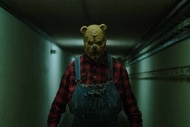Create a free profile to get unlimited access to exclusive videos, sweepstakes, and more!
For All Mankind's Ronald D. Moore calls Apple original 'Mad Men set at NASA'

For All Mankind, Apple TV+’s flagship series from Battlestar Galactica creator Ronald D. Moore, wowed fans with its alt-history trailer and now we’ve got some new info about the upcoming sci-fi show. The series — which stars Jodi Balfour, Joel Kinnaman, Michael Dorman, Shantel VanSanten, Wrenn Schmidt, and Sarah Jones among others — works off the premise that the U.S. was beaten to the moon by the Soviet Union.
Its stance is that, in the face of such defeat, American pride wouldn’t allow the space race to end. Instead, further and further goals would be set for space exploration as science tech was pushed forward at an almost desperate pace. This takes the historical series into science fiction, where Mars and Saturn are the aims of manned missions. It also means that some social strides happen much earlier, like a full class of trained female astronauts.
Keeping all this somewhat grounded (ha!) are former Apollo flight director Gerry Griffin and former NASA astronaut Garrett Reisman, two of the series’ NASA technical advisors. Griffin, Reisman (who actually made a cameo appearance in the series finale of Battlestar Galactica), and Moore spoke to SYFY WIRE and others on a conference call, giving plenty of details about the series — like how it originated, how it fits in with its peers, and what space exploration fans can expect.
The show came about because of a conversation Moore had with Reisman over lunch, as Moore was searching for a way for the space race to continue beyond Apollo 17. Reisman told Moore, “You don’t realize how close the Russians came to getting to the moon.” Looking for the catalyst that kicked off the “butterfly effect” resulting in America beating the Soviet Union to the moon, the pair decided that the 1966 death of Sergei Korolev (Chief Designer of the Soviet space program) was the beginning of the end.
To that end, their “deeper premise” is that Korolev lived through the botched surgery that killed him in real life. This accelerated the Soviet program and gave them the boost necessary to overtake the U.S. — not just in the realm of space exploration, but in global cultural dominance. Moore explained that the show will collect some of the sociopolitical ramifications of the event outside the walls of NASA, like how the Nixon administration reacts. A scene involving a character returning from Europe encapsulates this script-flip with her tales of children wearing hammer-and-sickle t-shirts.
Putting this all in context with other high-profile alt-history fictionm— like The Man in the High Castle, which was one of Amazon Prime’s first original series — For All Mankind stands out because it “starts at the beginning.” Moore explained that usually this subgenre “throws you into this existing world,” while For All Mankind will show the moment of deviation from real history. It’s also “aspirational” rather than “dark and dystopian,” which much alt-history leans towards. For All Mankind goes optimistic, showing how the world could’ve been improved if the space race had gone differently. Calling the series a kind of “Mad Men set at NASA,” Moore explained the show was very much about the ambitious characters in and around the space program that actually got a chance to put their big plans in action.
Those characters in the “ensemble piece” include astronauts Edward Baldwin (Kinnaman) and Gordo Stevens (Dorman), who will appear alongside real figures like Neil Armstrong and Buzz Aldrin, but also people like Ed’s wife, Karen (VanSanten) and Gordo’s wife, Tracy (Jones). Tracy was revealed to become an astronaut over the course of the series, mirroring real-life instances where spouses of astronauts were pilots in their own right. This is just one of many “Easter eggs” referencing little-known historical tidbits peppered throughout the show, which Moore says he spoke with Apple about.
“There might be resources for a viewer to dive deeper into some of these topics — I’m not sure how much of that will be available at the beginning or later — it’s still just a general talking point between us. But Apple does want an ability, eventually, for viewers to be able to do that kind of deep dive in the backgrounds in historical facts versus historical fictions of the show.” This would be a novel element to any streaming service, let alone one that’s promoting a serious sci-fi as its first big show.
Reisman and Griffin also explained how they worked to keep the show as accurate as possible — even when things didn’t always work out. Getting cathode-ray tube displays, for example, was a nightmare that the production team cheated by using flat-screen TVs and putting a piece of curved glass to simulate the old-school screens. The NASA logo was another difficulty. In watching the trailer, fans may notice the logo is just a little off, like the Bizarro version of the real-life NASA symbol. That’s because, as the trio explained, NASA has a policy to only lend support and use of emblems if the piece of media portrays the events of the space program exactly as they happened. Not really a possibility for an alt-history show.
But that's not to say the series doesn't celebrate reality. A new For All Mankind video featurette, which fans can check out below, celebrates the show in context of Apollo 11's 50th anniversary:
As for the future of For All Mankind, Moore says they “are definitely talking about a second season at this point” before the premiere, and “starting to get together stories and possible scripts” — even if “Apple hasn’t picked [For All Mankind] up officially” for another season. “We’re already moving ahead with planning in case they do,” Moore confirmed. Looks like Apple is showing confidence in its streaming investments already.
For All Mankind does not yet have a release date for its ten-episode season, but look for it this fall.


























